Communication is at the heart of any business experience, regardless of if by voice, text, or video, in person or virtual. But language barriers still exist, especially when rising immigration is bringing talent from different countries and companies are dealing with clients and partners across the sea. Thankfully, those barriers are breaking down through translation technology that helps bridge the gap. This includes devices, software, and apps, many of which leverage artificial intelligence (AI) to allow for casual, conversational, real-time translations. The technology works using computers, smartphones, earbuds, even smart glasses.
For those who need to communicate in another language, particularly in the business space, what are some of the technologies to consider?
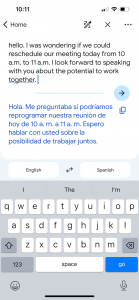 Google Translate
Google Translate
 The simplest option is to use Google Translate, which you can use on your smartphone, tablet, or computer. Call it up to translate from one language to another, back and forth. It can translate text you type as well as words spoken into device’s microphone. It can even listen to conversations and perform on-the-fly translations.
The simplest option is to use Google Translate, which you can use on your smartphone, tablet, or computer. Call it up to translate from one language to another, back and forth. It can translate text you type as well as words spoken into device’s microphone. It can even listen to conversations and perform on-the-fly translations.
Using Google Lens, you can also hover over text to see it converted to your native language, great for reading menus, product labels, and more. While it isn’t always 100% accurate, Google Translate and Google Lens can get you by in a pinch.
Smart Glasses and AI
AI technology can help with translations in many ways, and, as mentioned, you can find it across smartphones, tablets, computers, and even smart glasses. One of the most innovative devices in this space that I have tried are the
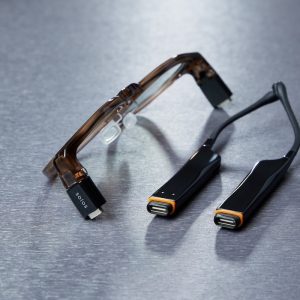
Solos AirGo 3 smart glasses.
The Live Translate feature, which requires a subscription, is tremendously useful for communicating with someone in a casual, conversational manner. Speak and you’ll hear your statement repeated in their native language, text appearing on screen as well. When they speak, the microphone picks up the audio and translates back what they are saying into your ears, displaying the text on screen.
At CES 2024, Solos announced the addition of new modes for this feature that are useful in business settings, including a Group mode to communicate with multiple individuals who speak different languages and a Present mode so you can conduct a presentation in the language you’re most comfortable speaking while the real-time audio translation happens for the audience in their preferred languages. Once the presentation is done, switch to the interactive Q&A session so everyone can chime in. Have a few of these glasses on hand to share with partners and converse as if there’s no language barrier at all.
Smartphones with Translation Features
Plenty of smartphones, including the Google Pixel 8 and Pixel 8 Pro and the Samsung Galaxy S24 series phones, support Live Translate. This allows for seamless chatting with someone talking in another language while you speak in yours, with real-time, two-way voice and text translation. It works even when you’re on an active phone call.
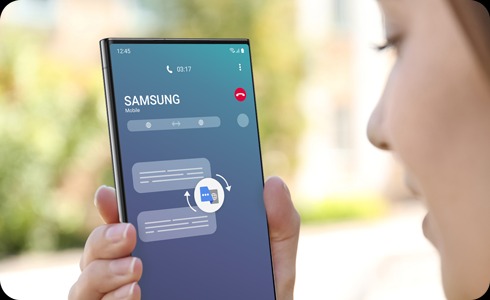
Galaxy S24 series
The Galaxy S24 series phones also have a feature called Interpreter that offers a split screen view of live conversations, so you see the translation of what the other person is saying on your device, and they see what you’re saying. The function works with or without an active cellular or Wi-Fi connection.
Google takes this a step further with a feature for the Pixel Fold foldable phone that displays the Dual Screen Interpreter mode on both sides of the same device.
Pixel Fold foldable phone
So, you could position the phone on a table between two people with the inner screen showing their translations and the outer screen showing yours for a seamless conversation. This could be ideal for interviewing candidates for a job who might feel more comfortable conversing in their native language, preventing you from missing out on hiring highly qualified individuals because of a language barrier.
Translation Earbuds
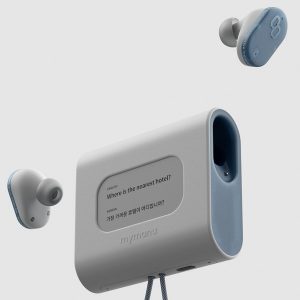
Mymanu CLIK Pro immersive translation earbuds
Many of these aforementioned translation features work with an app from your phone or other mobile device. So, once you have your device connected to a pair of earbuds, you can enjoy the audio translation through the earbuds versus the device’s built-in speaker. But there are also earbuds designed specifically for translating.
Named an Innovation Awards honoree at CES 2024 earlier this year was the Mymanu CLIK Pro immersive translation earbuds. They allow for translating in more than 50 languages, both in person or online, using the company’s proprietary translation system. The buds are set to be released in April 2024.
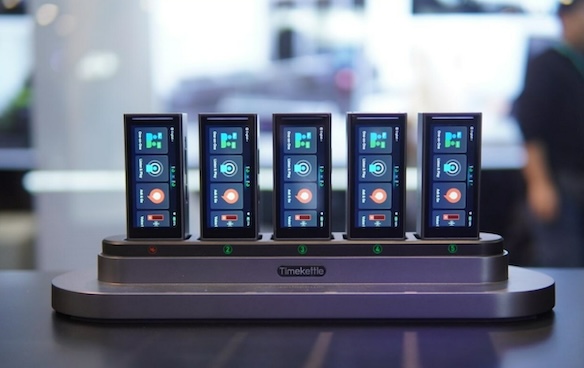
Timekettle X1 Interpreter Hub
Another Innovation Awards honoree at CES 2024 is the Timekettle X1 Interpreter Hub, which is ultra-compact and works hands-free with the companion wireless translator earbuds. Along with real-time interpretation during things like phone calls, it’s also designed for easy set-up in meeting rooms.
Pocket Translators
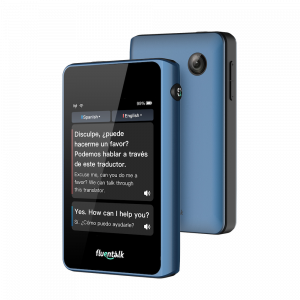
Fluentalk T1 mini translator
Ideal for travel when you need to communicate with service people, like in a restaurant or other place of business, or with passers-by on the street to ask questions about things like transit or public restrooms, a pocket translator is another option to consider. I took the Fluentalk T1 mini translator on a trip to Italy last summer. While most people in the service industry speak enough English to communicate with customers, once we traveled Castel Gandolfo outside of the main city of Rome, it was more difficult to converse. My 12-year-old son used the pocket translator to place an order for a drink.
Set the source and destination languages, hold the button, speak the phrase in your language then it repeats in the native language and displays the translated text on the screen. There’s offline translation for some languages, otherwise you need to activate the built-in SIM to use it without a Wi-Fi connection. The pocket-sized device ships with a year of global data included. In total, it can translate between 36 languages using 88 accents.
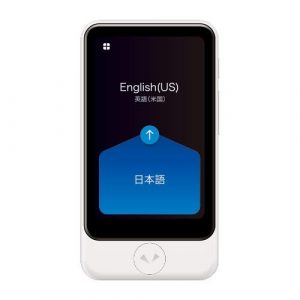
Pocketalk Plus Voice Translator
The Pocketalk Plus Voice Translator is a similar device that can translate 82 languages in the same manner and comes with the option for global LTE coverage. If you prefer a separate device, these pocket translators are perfect for travel.
Keep Talking
The concept of language barriers is effectively a thing of the past. With the right tools on both ends, you can seamlessly carry on a conversation, whether virtually or in person, with someone who doesn’t speak the same language as you. This is a game-changer for businesses that can now more easily conduct business without missing a beat, and without details being literally lost in translation.
Thanks to pocket devices, earbuds, smart glasses, apps, software, and AI, accurate, on-the-fly translation is already here. Of course, there’s still value in learning a language and being able to communicate without the need for additional tools, similarly to how it’s still useful to be able to conduct calculations without needing a calculator. But assistance in a pinch thanks to these types of tools can make the difference between a successful business partnership and a potentially lost one.
-30-



